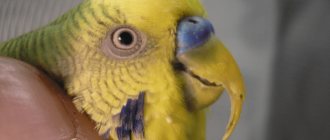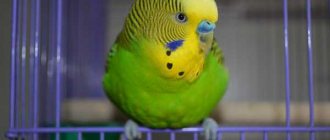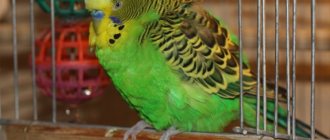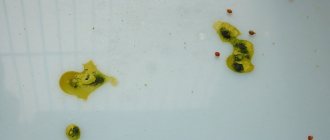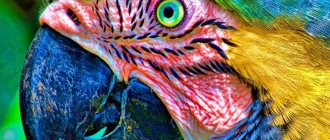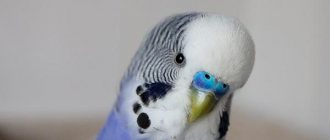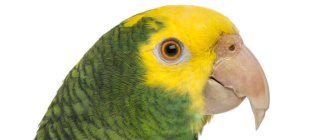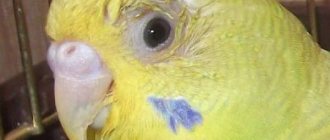The beak for a parrot, as for many other birds, is a vital organ. With its help, the bird not only feeds, as it crushes grains with its beak, but also does many other things vital to it. So a parrot using its beak:
- cleans himself up as he cleans his feathers;
- moves by clinging to a branch;
- feeds her babies;
- builds a house, carefully arranging every twig or straw;
- turns over their eggs, from which his offspring should be born.
Beak diseases
In a healthy state, both parts of the beak should independently grind against each other when the bird pulls twigs and eats solid food. If the beak is deformed, this does not happen. Such a bird requires care and timely qualified veterinary care from an ornithologist at home .
occur . In nature, it is impossible to help a chick born with a deformed beak; such a chick is doomed to death.
At home, you can save his life if you feed him, like all babies, every 3 hours. Having matured, the parrot will learn to eat and drink on its own, but will not fly often due to difficulty breathing.
In a sick parrot, the beak and its horny part begin to grow excessively quickly. The bird is trying to adapt, but it is uncomfortable for her to eat.
The claws are also subject to excessive growth, because they are related parts of the bird to the beak. If this is the upper part of the beak, then it can reach the crop and cause harm to it.
If the lower part of the beak grows quickly, it becomes soft and begins to break. In addition, the cornea takes on a creamy color. Sometimes such misfortunes are observed on the bird as the beak flaps crossing to the right and left. This happens more often in male parrots. The jaws cannot close properly.
There is an ailment of a completely opposite nature - a slowdown in the growth of the beak, and overlays appear on it. Cockatoo parrots are susceptible to a disease called overgrowth of both parts of the beak. The upper flap closes with the lower flap, and it turns out that the beak cannot close.
A disease such as facial scabies, or cnemidocotosis, is also related to It has its own pathogen - the tick. This disease is being treated at the NEOTLOZHKA veterinary clinic , and the beak is being restored.
Birds can get microbes, fungi, and viruses along with their food. These organisms can affect weakened birds. A tumor may develop in the parrot's beak. This is hypovitaminosis A. The parrot is unable to hold food with its beak, is losing weight, does not play, is depressed, sits without reacting to anything, ruffled. The bird has swelling of the tongue and the beak is therefore open.
In order for the bird to remain alive, you need to seek help from a veterinarian or ornithologist ; it must be force-fed, putting food directly into the throat. This must be done until complete recovery.
Cerebellar hyperkeratosis in parrots
The cere is an area of thickened skin above the beak of birds on which the nostrils are located. The main function is to facilitate the movement of the beak. Sometimes it happens that it grows and bothers the parrot - in this article we will learn how to recognize and help the bird.
The wax is found on the beaks of parrots, pigeons, owls and the order of Falconiformes. Normally, the skin in this area is featherless, smooth, and has a uniform structure and color.
The cere of a young male is lilac or light purple, evenly colored, including the visible part of the nostrils. Or there may be lighter blue circles around the nostrils. By six months, the male's cere becomes a rich purple/dark blue color. The cere of a young female is usually blue with white circles. It can also be almost completely white, off-white or beige; by about 7-8 months it becomes covered with a brown crust, which is the norm for a female.
Do not be alarmed if the parrot's cere changes color if the bird is young. Until the bird is 35 days old, the color of the wax and plumage may change and this is the norm. Up to 1.5 months, young parrots have a black mark that reaches the middle of the beak; later it disappears.
If a bird's wax color has changed, this indicates its sexual maturity.
In male budgies of some colors, such as lutino and albino, the cere may not turn blue throughout its life.
But there are certain diseases that can affect the wax. Let's consider today such a problem as hyperkeratosis.
What is hyperkeratosis
Hyperkeratosis is a disease that is characterized by thickening of the cere associated with the formation and growth of the keratinized layer of epithelial cells. The color may change either completely or in patches, becoming dark brown. More often the disease is registered in females. Hyperkeratosis is not contagious and does not pose a danger to other birds, but it negatively affects the reproductive system.
Causes of hyperkeratosis
The causes of waxy hyperkeratosis are most often hormonal disorders, as well as a deficiency of vitamin A in the diet. Less commonly, the disease can be idiopathic. In the wild, parrots eat a fairly large amount of plant foods rich in essential vitamins, minerals and other nutrients, but when in captivity they often suffer from an imbalance, which can lead to hyperkeratosis and other negative consequences.
Diagnosis of waxy hyperkeratosis
Based on its external signs, hyperkeratosis can be confused with other diseases of an infectious and non-infectious nature.
To confirm the diagnosis, you need to contact an ornithologist who will conduct an examination and, if necessary, take a scraping. The main signs of hyperkeratosis are:
- Growth of the cere in length and width
- Thickening
- Dryness and roughness, unevenness of the wax
- No pain
- Periodic plaque may form on the beak
- Change in wax color to darker, appearance of spots
- Peeling of the cere
- The tissue can grow so large that it makes it difficult for the bird to breathe, blocking the bird's nostrils.
- In advanced cases, signs of hyperkeratosis are also visible on the paws.
The difference from other diseases of the cere may be the absence of swelling, pain, discharge from the nostrils, the presence of blood or pus, which distinguishes hyperkeratosis from knemidocoptosis and necrosis of the cere. The owner should also pay attention to the condition of the pet as a whole: what the feather looks like, whether there are any areas of baldness, whether thirst and appetite are preserved, whether the litter is normal. All this information will help make the correct diagnosis as quickly as possible.
Treatment and prevention
Hyperkeratosis is not a deadly disease; treatment occurs in a fairly short time.
First of all, you need to adjust your diet. Be sure to add foods that are rich in vitamin A to your food: carrots, dandelion, bell peppers, lettuce, tomatoes, root vegetables with brightly colored pulp and greens. In this case, the grain mixture rate can be slightly reduced. Additionally, vitamin complexes can be added to the diet. Vitamin A (retinol) should be applied topically to the cere in very small quantities for about 10 days, with a soft brush or cotton swab in a thin layer, making sure that it does not get into the eyes, nostrils and beak; vitamin A solution is not applied internally. You can use Vaseline oil, also applied to the wax, to soften it. As a result, the keratinized layer of the cere falls away, revealing a clean cere underneath. A speedy recovery will be facilitated by reducing the daylight hours for the bird and, accordingly, the period of wakefulness. It is advisable not to self-medicate or use drugs by eye, in order to avoid overdoses or incorrectly constructed treatment regimens.
Treatment methods for pharyngitis
Treatment must be comprehensive. The patient is prescribed medications that will relieve pain and reduce inflammation. It is also important to adhere to a special diet and exclude from the diet foods that irritate the mucous membrane of the throat and bring even more discomfort: alcoholic beverages, spicy and salty foods, sour foods, carbonated drinks.
Drug therapy
Depending on the clinical picture and general condition of the patient, the doctor may prescribe antihistamines, antitussives and antiviral medications. Lozenges/lozenges are used to relieve pain.
In some cases, they resort to the use of antibiotics. They can only be taken as directed by a doctor.
Local impact
Rinsing with special solutions also has a good effect on the inflammatory process and redness of the larynx. They have a gentle effect, relieve pain and improve the general condition of the patient.
To diagnose and identify the disease, you need to consult an otolaryngologist. At the city clinic, you can contact your primary care physician, who will issue a referral to an ENT specialist. However, this takes time. You often have to wait 2 weeks for an appointment with a doctor. In some cases, this is simply impossible, since it is necessary to quickly conduct an examination and prescribe treatment before the situation becomes critical.
Therefore, we recommend contacting the Medunion medical clinic. We employ practicing otolaryngologists, and you don’t have to wait several weeks for appointments. Sign up today for a time convenient for you, and get tested tomorrow.
Patients choose us because we provide the service of a specialist coming to your home if you cannot come to the clinic on your own. You can also take samples directly at home.
The cost of an initial consultation with an otolaryngologist in Krasnoyarsk at the Medunion clinic starts from 1,300 rubles. You can sign up on the website or by calling 201-03-03.
Features of treatment for parasites
If a parrot has a growth and its beak turns black, this may indicate the presence of parasites. But in addition to growths, other symptoms may be present:
- the parrot scratches the growths;
- the growth can exfoliate and grow;
- the appearance of white and greenish spots on the paws and growth.
All these symptoms can occur when a bird is infected with mites. The mites themselves can only live on the body of parrots; they are not dangerous to humans.
You won’t be able to help yourself at home; it can only harm your pet’s health. Only an experienced doctor can provide examination and treatment, but it is important to start it as early as possible, otherwise the feathered pet may die.
What actions should you take if you have ticks?
The main symptom when a partial mite appears is severe itching of the area with the growth. If you notice that your bird is scratching its beak frequently, it most likely has a mite. Soon a tumor and severe growth of the cornea may appear.
In these cases, you can use the following recommendations:
- First you need to carefully examine your feathered pets. Perhaps, in addition to the growth on the surface of the beak, they developed spots on the surface of the paws, cloaca and eyelids;
- If parasites appear in only one parrot, then it needs to be removed from all of them. This is necessary for prevention;
- a sick feathered pet can be temporarily transplanted into a clean cage or an ordinary box, which after recovery will need to be thrown out and burned;
- All perches, toys, drinking bowls, and mineral stones should be thrown away. The fact is that a tick can live on them for three months;
- Completely clean the cage. First you need to wash it with a weak soap solution. Then treat it with one of the drugs - Neostomozan, Virkon, Virocide, Ecocide S, potassium permanganate. For example, one ampoule of Neostomozan is diluted in 400 ml of water. The resulting solution is enough to wash one cell. After treatment, everything must be rinsed well with hot water, the main thing is that the substance is all washed away, otherwise the pet may be poisoned;
- A thin layer of aversectin ointment is applied to the affected areas. These treatments must be performed every 3 days. In advanced cases, when the beak has turned black, it can be used once every two days. Treatments are carried out until the growth completely disappears.
Causes
However, such a hardy and strong beak can also get damaged and even endanger the life of your beloved bird. The fact that your pet has problems with its beak can be signaled by its darkening. But if a parrot’s beak has turned black, this does not mean that it is terminally ill and it is necessary to urgently begin treatment with the help of all medications that can come to mind. Dark spots can occur for the following reasons:
- The bird may injure or stuff its beak.
- There is a disturbance in the processes of blood circulation and coagulation in her body.
- Consumption of feed that contains dyes.
- Young age.
- Poisoning.
- Liver problems.
- Unbalanced diet.
- Failure to comply with hygiene rules.
Deformations
Although the beak is very hard and firmly attached, it can become deformed. There is a congenital malformation when a chick is born with an irregularly shaped horn. Most often, such birds do not survive because they do not adapt to grab food. The problem may go away over time if the top and bottom parts close together, otherwise the pet will need special care for the rest of its life.
If a parrot's beak becomes bent at an early age, when the keratoid membrane is pliable, things can still change. When the growth zone is affected, irreversible complications arise. With curved, intersecting halves, shape correction is possible. It is important to see the deformation in time and help the pet. Inexperienced owners do not immediately notice that the parrot’s beak has become crooked. The cause may be an adult bird colliding with an obstacle, for example, hitting glass.
Associated symptoms
It is very important to pay attention to accompanying signs of illness in your pet. Along with a broken beak, the following symptoms may be observed:
- nausea and vomiting;
- falling from a perch;
- loss of balance;
- lethargy;
- frizz;
- indifference to the environment;
- excessive growth of the beak;
- peeling and separation of the horny part;
- the appearance of various growths.
Associated symptoms help identify a specific disease. If the owner cannot understand the cause and begin effective treatment, then he should contact a specialized ornithologist for prescriptions.
How to care for a parrot with a cracked beak?
Everything you do should be recommended by your veterinarian. For minor fracture-related injuries, maintaining your parrot, pain medication, and antimicrobials should be all you need to help your bird heal and grow another healthy beak.
For larger, deeper injuries, dental acrylic putty and a bonding light can be used to hold the beak in place until a new one grows.
A cracked beak can be completely healed as long as blood flow is not obstructed. But some beak injuries can be long-lasting, in which case the parrot will need to be fed only soft food for the rest of its life. These soft foods may include small pieces of soft fruits, vegetables, boiled eggs and so on.
If your parrot is unable to eat normally due to a beak injury, you may want to separate him from other parrots or pets so you can monitor his eating and hand feed him if necessary.
Features and structure of a parrot's beak
The beak of a budgerigar is one of the important organs, without which its existence would be impossible. Thanks to it, the bird crunches seeds and bites off pieces of food, without which the budgie cannot survive for long. Therefore, any abnormalities in this organ must be urgently treated.
The beak of a bird is a stratum corneum or membrane that covers the bone tissue of the jaw from the outside and inside. It consists of two parts: the mandible and the mandible.
These bones are connected to the bird's skull using a tendinous ligament, and thanks to it the upper part can move. At the top of the beak, budgerigars have a cere. Its color depends on the sex and age of the parrot.
The parrot's beak is constantly growing, and the bird constantly wears it off. The smaller the bird, the slower the growth rate. Throughout life, the base of the beak grows and moves forward, replacing the layers it wears off.
A human fingernail grows in much the same way. After some time, the beak is completely renewed, which means that all damage, scratches, peeling and cracks disappear after some time. The mandible is renewed approximately once every six months, and the mandible is a little faster.
For budgerigars, the beak replaces teeth, as birds use it to crush and crush food. In addition, this organ serves to build nests, because parrots gnaw out nests for themselves where they hatch eggs. With its help, the female turns the eggs, feeds the chicks, and also cleans the feathers.
Do not underestimate the role of the budgerigar's beak in communication and self-defense. Biting a wavy can be very painful. Thanks to its rounded shape, the parrot can use this organ to move along branches or along the bars of the cage, using it as a support and fixation of its body.
The sensitivity possessed by the receptors at the tip of the beak is capable of recognizing cold and hot.
What factors can cause this disease?
Many may often ask the question, why does a budgerigar's beak peel off? This disease can be caused by the following reasons:
- growths provoke hormonal disorders that can occur during poor nutrition or poor quality care;
- various parasites, namely the effects of ticks;
- if a pet’s beak darkens, this can occur under poor living conditions - a dirty, untidy cage, untreated internal elements of the home;
- exposure to bacteria;
- manifestations of hyperkeratosis. This disease is characterized by increased proliferation of corneal tissue;
- herpes virus.

